

These 40 Maps Will Help You Understand The World Better. Cool! Ever wonder which side of the road different parts of the world drive on?

How about what Pangea would look like with today’s international borders? What about where the TV remote is located? Well, this post has the answer to the first two questions and more--and they’re all in map form. For the remote, just check under the couch again. Check out these maps and see if things make more sense to you! 1.) 2.) 3.) 4.) 5.) 6.) Thinking. System Theory. Origin of language. The origin of language in the human species has been the topic of scholarly discussions for several centuries.
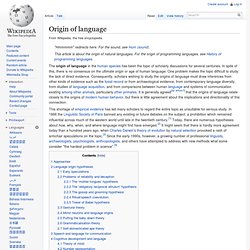
Philosophy of language. Language and thought. A variety of different authors, theories and fields purport influences between language and thought.
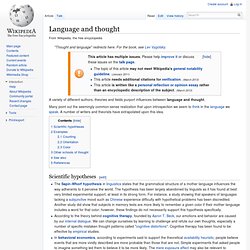
Many point out the seemingly common-sense realization that upon introspection we seem to think in the language we speak. A number of writers and theorists have extrapolated upon this idea. Cognitive distortion. Psychiatrist Aaron T.
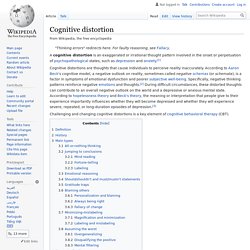
Beck who laid the groundwork for research on cognitive distortion. Defence mechanisms. A defence mechanism is a coping technique that reduces anxiety arising from unacceptable or potentially harmful impulses.[1] Defence mechanisms are unconscious and are not to be confused with conscious coping strategies.[2] Sigmund Freud was one of the first proponents of this construct.[3] Healthy persons normally use different defences throughout life.
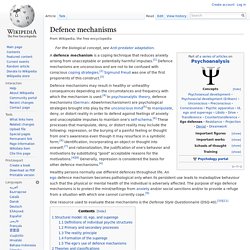
Function (engineering) In the lifecycle of engineering projects, there are usually distinguished subsequently: Requirements and Functional specification documents.
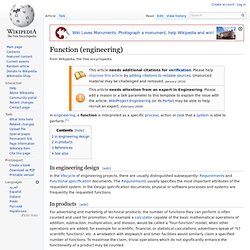
The Requirements usually specifies the most important attributes of the requested system. In the Design specification documents, physical or software processes and systems are frequently the requested functions. Simulation. Wooden, mechanical, horse simulator during World War I. Simulation is used in many contexts, such as simulation of technology for performance optimization, safety engineering, testing, training, education, and video games. Often, computer experiments are used to study simulation models. Simulation is also used with scientific modelling of natural systems or human systems to gain insight into their functioning.[2] Simulation can be used to show the eventual real effects of alternative conditions and courses of action. Simulation is also used when the real system cannot be engaged, because it may not be accessible, or it may be dangerous or unacceptable to engage, or it is being designed but not yet built, or it may simply not exist.[3] Classification and terminology[edit] Physical simulation refers to simulation in which physical objects are substituted for the real thing (some circles[4] use the term for computer simulations modelling selected laws of physics, but this article doesn't).
Conceptual model. A conceptual model is a model made of the composition of concepts, which are used to help people know, understand, or simulate a subject the model represents.

Some models are physical objects; for example, a toy model which may be assembled, and may be made to work like the object it represents. The term conceptual model may be used to refer to models which are formed after a conceptualization (generalization)[1] process in the mind. Conceptual models represent human intentions or semantics[citation needed][dubious ]. Conceptualization from observation of physical existence and conceptual modeling are the necessary means that humans employ to think and solve problems[citation needed].
Concepts are used to convey semantics during natural language based communication[citation needed]. Outline of thought. Nature of thought[edit] Thought (or thinking) can be described as all of the following: An activity taking place in a: brain – organ that serves as the center of the nervous system in all vertebrate and most invertebrate animals (only a few invertebrates such as sponges, jellyfish, adult sea squirts and starfish do not have a brain).

It is the physical structure associated with the mind. mind – abstract entity with the cognitive faculties of consciousness, perception, thinking, judgement, and memory. Having a mind is a characteristic of humans, but which also may apply to other life forms.[1][2] Activities taking place in a mind are called mental processes or cognitive functions.computer (see automated reasoning, below) – general purpose device that can be programmed to carry out a set of arithmetic or logical operations automatically. List of thought processes. Nature of thought[edit] Thought (or thinking) can be described as all of the following: An activity taking place in a: brain – organ that serves as the center of the nervous system in all vertebrate and most invertebrate animals (only a few invertebrates such as sponges, jellyfish, adult sea squirts and starfish do not have a brain).
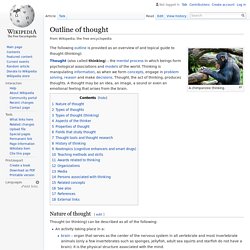
It is the physical structure associated with the mind. mind – abstract entity with the cognitive faculties of consciousness, perception, thinking, judgement, and memory. Having a mind is a characteristic of humans, but which also may apply to other life forms.[1][2] Activities taking place in a mind are called mental processes or cognitive functions.computer (see automated reasoning, below) – general purpose device that can be programmed to carry out a set of arithmetic or logical operations automatically. Strategy List: 35 Dimensions of Critical Thought. S-1 Thinking Independently Principle: Critical thinking is independent thinking, thinking for oneself.
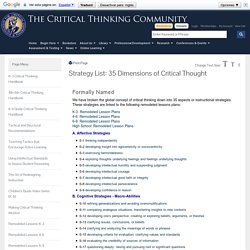
Many of our beliefs are acquired at an early age, when we have a strong tendency to form beliefs for irrational reasons (because we want to believe, because we are praised or rewarded for believing). Critical thinkers use critical skills and insights to reveal and reject beliefs that are irrational. In forming new beliefs, critical thinkers do not passively accept the beliefs of others; rather, they try to figure things out for themselves, reject unjustified authorities, and recognize the contributions of genuine authorities. They thoughtfully form principles of thought and action; they do not mindlessly accept those presented to them.
If they find that a set of categories or distinctions is more appropriate than that used by another, they will use it. Independent thinkers strive to incorporate all known relevant knowledge and insight into their thought and behavior. Go to top. Strategy List: 35 Dimensions of Critical Thought. Taboo. A taboo is a vehement prohibition of an action based on the belief that such behavior is either too sacred or too accursed for ordinary individuals to undertake, under threat of supernatural punishment.[1][2] Such prohibitions are present in virtually all societies.[1] The word has been somewhat expanded in the social sciences to strong prohibitions relating to any area of human activity or custom that is sacred or forbidden based on moral judgment and religious beliefs. [citation needed] "Breaking a taboo" is usually considered objectionable by society in general, not merely a subset of a culture. Etymology[edit] Not one of them would sit down, or eat a bit of any thing....
On expressing my surprise at this, they were all taboo, as they said; which word has a very comprehensive meaning; but, in general, signifies that a thing is forbidden.[4] When any thing is forbidden to be eaten, or made use of, they say, that it is taboo.[5] Iconoclasm. "Triumph of Orthodoxy" over iconoclasm under the Byzantine empress Theodora.
Late 14th – early 15th century icon. Iconoclasm[Note 1] is the destruction of religious icons and other images or monuments for religious or political motives. In time, the word, usually in the adjectival form, has also come to refer to aggressive statements or actions against any well-established status quo. Politics of memory. The politics of memory is the political means by which events are remembered and recorded, or discarded. The terminology addresses the role of politics in shaping collective memory and how remembrances can differ markedly from the objective truth of the events as they happened. The influence of politics on memory is seen in the way history is written and passed on. Cyprus[edit] The two sides in the conflict in Cyprus maintain widely divergent and contrasting memories of the events that split the island.
The term selective memory is applied by psychologists to people suffering from head injuries who retain some memories, but have amnesia about others. The selectivity may also serve a political purpose, for example to justify the claims of one group over a competing group. Memory. Overview of the forms and functions of memory in the sciences In psychology, memory is the process in which information is encoded, stored, and retrieved. Encoding allows information that is from the outside world to reach our senses in the forms of chemical and physical stimuli.
In this first stage we must change the information so that we may put the memory into the encoding process. List of memory biases. List of common misconceptions. From Wikipedia, the free encyclopedia This incomplete list is not intended to be exhaustive. This list corrects erroneous beliefs that are currently widely held about notable topics. Each misconception and the corresponding facts have been discussed in published literature. List of fallacies. List of cognitive biases. List of cognitive biases. Spiritual Inquiry . com » 160 Zen stories.